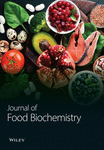Phytochemicals in Chronic Noncommunicable Diseases: A Bibliometric Study
Abstract
Background. Phytochemicals are compounds that are naturally found in plants and are known to have various health benefits. However, phytochemicals are structurally complex, inherently unstable, and have low bioavailability. Unfortunately, research on phytochemicals lags behind that of essential nutrients. This paper focuses on a bibliometric analysis to understand citation patterns in phytochemical research related to chronic diseases. It examines the current state of research, research focal points, and anticipated trends in the field. Methods. We analyzed published literature on phytochemicals and chronic diseases using the Web of Science database. Our search included only English-language publications until April 1, 2023. Visual Metrics software was used to examine data on countries, institutions, authors, journals, and citations. Results. For this study, a total of 2,297 articles were retrieved from 2008 to the present, with a significant increase in citations starting in 2017. China was found to be the leading country in paper production, while the United States had the highest H-index, placing both at the forefront of research in this field. King Saud University published the most, and Liu RH emerged as the most influential author. The analysis showed limited collaboration between institutions across different countries. Molecules were the primary source for phytochemical-related papers. The top 20 keywords highlighted flavonoids and their association with cardiovascular diseases, indicating them as prominent themes in recent phytochemical research with the potential to remain relevant. Conclusions. The study highlights the increasing interest in phytochemical research related to chronic diseases. It provides a thorough review and analysis of the present situation, the latest research topics, and academic trends in this field. This information is precious for researchers and healthcare professionals. It helps them to comprehend significant literature and keep up-to-date with the latest advancements in the field, eventually leading to progress in this field.
1. Introduction
Phytochemicals, also known as biologically active substances, are non-nutritive secondary metabolites that naturally occur in plant-based foods. Examples of such plant-based foods include whole grains, vegetables, fruits, legumes, nuts, and herbs. These compounds can be classified based on their chemical structures into categories such as carotenoids, phytosterols, saponins, polyphenols, sulfides, and phytic acids [1]. In addition to serving as precursors to vitamins, some phytochemicals are nutrients, while the majority of phytochemicals are non-nutrients. Phytochemicals are not essential for human growth and development, but they do play a crucial role in regulating physiological functions, preventing diseases, and maintaining physical health. This study mainly considers the main phytochemicals that have preventive and therapeutic effects on chronic diseases. They are particularly effective in preventing hypertension, coronary heart disease, stroke, other cardiovascular and cerebrovascular diseases, some tumors, obesity, type 2 diabetes, and other chronic/noncommunicable diseases [2, 3]. Phytochemicals are difficult to study due to their complex chemical structure, unstable properties, and low bioavailability compared to nutrients.
Bibliometrics is a field of study that uses mathematical and statistical methods to analyze the literature on a particular academic subject. This method helps in understanding the structure, distribution, quantitative relationships, and patterns of change within a specific field. By using bibliometrics, researchers can quickly explore the disciplinary structure and research frontiers of a particular academic field. Two widely used Java-based software tools in scientific literature measurement and visual analysis are CiteSpace and VOSviewer. These tools use various metrics, cooccurrence analysis, and clustering techniques to identify hotspots and frontiers within a certain field. Developed by Dr. Chao-Mei Chen at Drexel University in the United States in collaboration with the WISW laboratory, CiteSpace is a citation visualization and analysis software that can display the development of specific knowledge domains [4]. VOSviewer is a software tool that is free to use and was developed by the Science and Technology Research Center at Leiden University in the Netherlands in 2009. The tool is primarily used for analyzing literature data and creating visual representations of scientific knowledge maps. It enables researchers to visualize their research landscapes in an easy and effective way [5]. Biblioshiny is an open-source online visualization software based on RStudio [6]. They have many advantages in literature analysis and statistics, indicator calculation, network analysis, knowledge mapping, and so on.
Analyzing the publications related to phytochemicals in the medical field can provide valuable insights into the current research status, guide future developments, and shed light on the prospects of phytochemicals as a potential intervention in diseases. It can also aid in the development of new phytochemicals and provide a fresh perspective for journal development. This paper aims to perform a bibliometric analysis of publications on phytochemicals in the medical field to identify major hotspots and current research trends. By understanding the characteristics of relevant papers, such as citation frequency, research topic, author, publication year, journal, contribution institution, and source country, we can gain a better understanding of the research landscape.
2. Materials and Methods
2.1. Data Source and Retrieval Strategy
The data used in this study were obtained from the Web of Science (Core Collection) database, which is widely recognized in academic circles as a high-quality literature resource. The detailed search strategy is presented in Table 1. The data were retrieved from the database up to April 1, 2023, and the literature was limited to English-language publications. Conference papers, revisions, duplicates, unpublished works, letters, briefs, news, book reviews, and any literature that was not related to the field of study were excluded. The flowchart depicting the literature screening process is presented in Figure 1. In total, 2,297 articles were included for analysis.
| Set | Search query |
|---|---|
| #1 | TS = (Phytochemical ∗ or phytonutrient ∗ or (plant-derived chemical ∗) or (plant-derived Compound ∗)or (plant-derived compound ∗)or (phytochemical ∗, dietary) or (plant bioactive compound ∗) or (plant biologically active compound ∗) or (plant-derived chemical ∗) or (dietary phytochemical ∗) or (bioactive compound ∗, plant) or (bioactive compound ∗, plant) or (biologically active compounds, plant) or (compound ∗, plant bioactive) or (compound ∗, plant-derived) or (chemical ∗, plant-derived) or (compound ∗, plant bioactive)) |
| #2 | TS = ((Chronic disease ∗) or (disease ∗, chronic) or (chronic illness ∗) or (chronic condition ∗) or (chronically Ill) or (illness ∗, chronic) or (condition, chronic)) |
| #3 | TS = ((Non-communicable disease ∗) or (noninfectious disease ∗) or (non-communicable disease ∗) or (non-communicable disease ∗) or (noninfectious disease ∗) or (non-communicable chronic disease ∗) or (non-communicable chronic disease ∗) or (noninfectious disease ∗) or (disease ∗, non-communicable) or (chronic disease, non-communicable)) |
| #4 | #2 OR #3 |
| #5 | #1 AND #4 |

2.2. Research and Analysis Methods
We have used the bibliometric method to analyze a vast amount of literature data using software such as CiteSpace (6.2.R7) and VOSviewer (1.6.19). This helped us identify countries/regions, institutions, authors, journals, keywords, and more to conduct scientometric and visualization analysis. Through this analysis, we were able to present the general trend of research in the field, the distribution, the changes in hotspots, etc. We also used software such as Origin, SCImage (1.0.0), Biblioshiny (4.0.0) [6], and Pajek to assist in our analysis. Finally, we carried out an in-depth analysis of the classification of phytochemicals and their application in chronic/noncommunicable diseases through manual classification by keyword clustering. The specific process of literature scientometric and visual analysis is shown in Figure 1.
3. Results
3.1. Analysis of the Number of Annual Publications
After applying the inclusion and exclusion criteria, we retrieved a total of 2,297 articles from the core database of Web of Science, ranging from 2008 to 2023. On average, 144.6 articles were published annually. Figure 2 shows the consistent growth in the research on phytochemicals and chronic diseases since 2008. There are two rapid growth stages, beginning in 2017 and then again in 2020, which are represented in the graphical representation. The number of papers published reached its peak in 2021 and 2022, with 371 papers each year, indicating a rapid advancement in this field. Although the data are incomplete for 2023 due to the limitations of the search date, the field continues to exhibit ongoing growth and development.
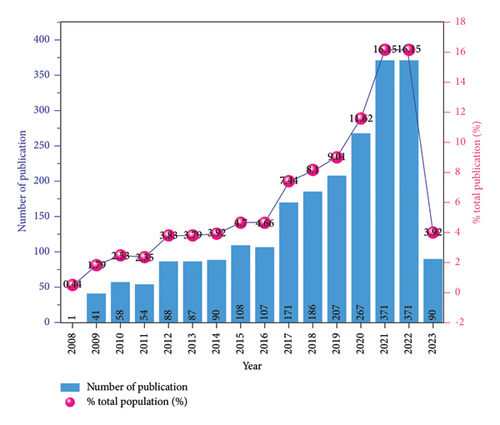
3.2. Analysis of Research Countries, Institutions, and Authors
3.2.1. Country Visualization Analysis
From 2008 to 2023, the top 30 countries and regions involved in global research on phytochemicals in the context of chronic diseases or noncommunicable diseases were identified. The results are presented in Figure 3(a). China had the highest number of publications, with 407, representing 17.72% of the total. The United States came second with 398 publications (17.33%) and India came third with 311 publications (13.54%). Figure 3(b) shows the total link strength (TLS) between countries in this field. The United States had the strongest research connections with other nations, with a TLS of 296, followed by China with a TLS of 244 and India with a TLS of 230. Figure 3(c) visually illustrates that both China and the United States experienced significant research growth after 2016, while India’s research output began to surge after 2020.
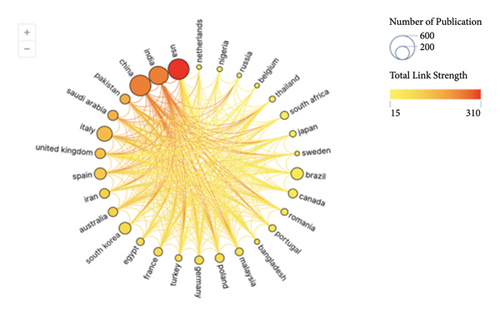
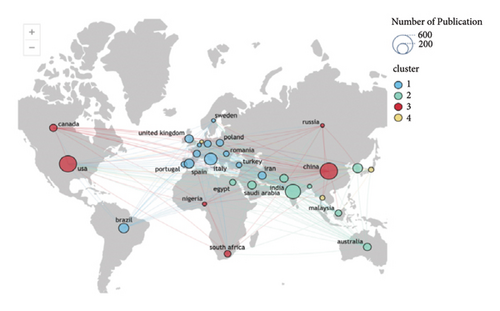
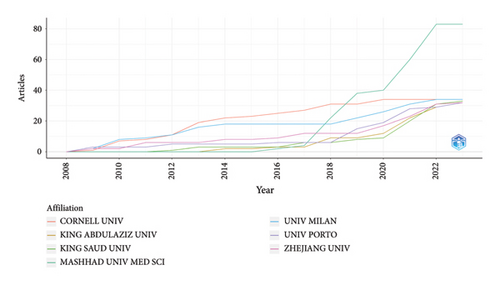

The H-index was created by Professor J. E. Hirsch, a physicist from the University of California in 2005. It is a metric used to measure academic influence, indicating that an individual has authored H papers, each of which has been cited at least H times. In Figure 3(d), you can see the H-index distribution among the top 30 countries with the highest publication volumes. The United States holds the highest H-index at 2711, with China (1112) and the United Kingdom (1707) following in the second place and third place, respectively. However, it is important to note that the H-index can vary depending on factors such as academic development timelines, diverse disciplines, and other influencing factors. Thus, it serves as a reference point rather than an absolute measure.
3.2.2. Institutional Visualization Analysis
Figure 4(a) presents the top 30 national research institutions globally, which are focused on chronic/noncommunicable disease research using phytochemicals. The list is based on the highest number of publications from 2008 to 2023. King Saud University and Cornell University are ranked first and second with 29 and 26 publications, respectively. Mashhad University of Medical Sciences from Iran is in the third position with 23 publications. On the other hand, Figure 4(b) shows that the publications of King Saud University have increased rapidly after 2017, while other institutions are still in the stage of steady growth.
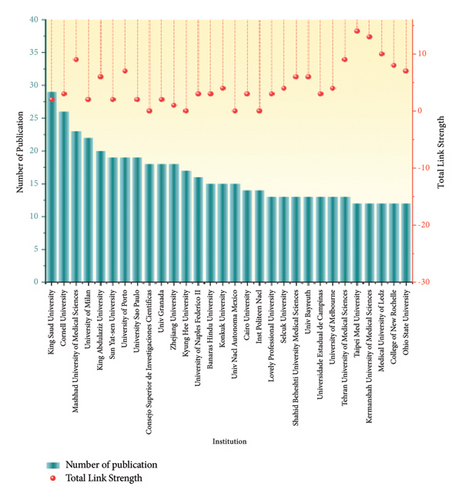
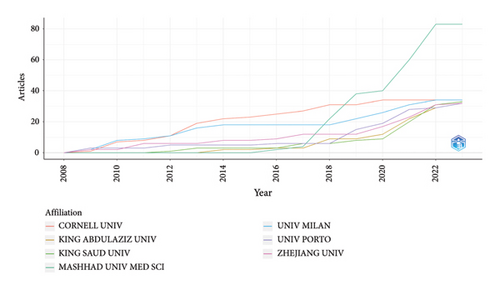
3.2.3. Author Visualization Analysis
Based on the cooccurrence analysis of authors, it can be observed from Figure 5(a) that Liu RH has published the highest number of articles in this field so far, with a total of 24 publications to their name. Sahiebkar A secures the second position with 19 publications, and Zengn G ranks third with 14 articles published. In Figure 5(b), the shadow of the color represents the author’s citation rate, while the size of the circle represents the number of publications. Liu RH has the largest number of publications and has been researching in this field for a long time. His research paper titled “Health-Promoting Components of Fruits and Vegetables in the Diet,” published in 2013 has received the highest number of citations throughout his research career, totaling 666 citations as of May 2023. Based on Figure 5(c), which is presented in the form of a Sankey diagram, we can see the most commonly used keywords by the primary authors in this field. These keywords include phytochemicals, inflammation, oxidative stress, antioxidation, cancer, flavonoids, anti-inflammatory, diabetes, and more. Notably, China, the United States, India, and Italy have contributed significantly to the research in this area.
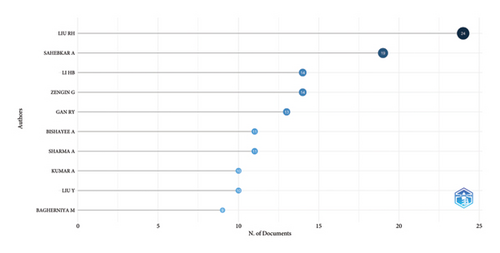

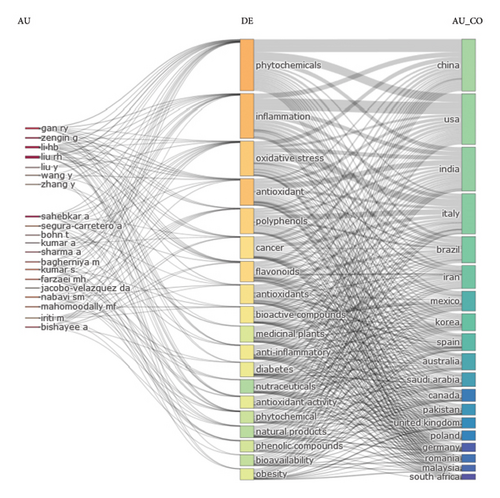
3.3. Cooccurrence Analysis of Journals
Between 2008 and 2023, the top 30 journals in this field published a total of 985 articles, which accounted for 42.9% of the entire literature output. According to Table 2, “Molecules” was the leading journal in terms of publication count, with 115 articles published. “Journal of Ethnopharmacology” came in second with 87 published articles, while “Nutrients” ranked third with 81 publications. These statistics serve as a valuable reference for future authors in this field. Table 3 highlights the 30 journals with the highest number of citations, most of which engage in interdisciplinary research. Figure 6(a) visually represents the distribution of the main 16 journals among the top 30. The remaining journals show a relatively uniform distribution, indicating a certain level of dispersion in research within this field. Figure 6(b) illustrates the publication trends in the five journals with the highest number of papers related to phytochemicals in the context of chronic diseases. Notably, “Molecules” experienced significant growth after 2019 and currently has the highest publication count in this field, followed by “The Journal of Ethnopharmacology” and “Nutrients.”
| Rank | Number of publication | % of the total publication | Journal | |||
|---|---|---|---|---|---|---|
| Name | Country/Region | Impact factor (2022) | H-index (2022) | |||
| 1 | 115 | 5.007 | Molecules | Switzerland | 4.927 | 171 |
| 2 | 87 | 3.788 | Journal of Ethnopharmacology | Ireland | 5.195 | 205 |
| 3 | 81 | 3.526 | Nutrients | Switzerland | 6.706 | 143 |
| 4 | 56 | 2.438 | International Journal of Molecular Sciences | USA | 6.208 | 195 |
| 5 | 55 | 2.394 | Critical Reviews in Food Science and Nutrition | USA | 11.208 | 173 |
| 6 | 52 | 2.264 | Antioxidants | Switzerland | 7.675 | 61 |
| 7 | 51 | 2.22 | Frontiers in Pharmacology | Switzerland | 5.988 | 104 |
| 8 | 35 | 1.524 | Food and Function | England | 6.317 | 89 |
| 9 | 35 | 1.524 | Journal of Agricultural and Food Chemistry | USA | 5.895 | 310 |
| 10 | 27 | 1.175 | Biomedicine and Pharmacotherapy | France | 7.419 | 109 |
| 11 | 26 | 1.132 | Phytomedicine | Germany | 6.656 | 127 |
| 12 | 26 | 1.132 | Plants-Basel | Switzerland | 4.658 | — |
| 13 | 25 | 1.088 | Food Chemistry | United Kingdom | 281 | 9.231 |
| 14 | 24 | 1.045 | Food Research International | USA | 7.425 | 177 |
| 15 | 23 | 1.001 | Foods | Switzerland | 5.561 | 53 |
| 16 | 22 | 0.958 | Journal of Food Biochemistry | USA | 3.654 | 50 |
| 17 | 21 | 0.914 | Oxidative Medicine and Cellular Longevity | USA | 7.310 | 114 |
| 18 | 20 | 0.871 | Evidence-Based Complementary and Alternative Medicine | United Kingdom | 2.650 | 100 |
| 19 | 19 | 0.827 | BMC Complementary and Alternative Medicine | United Kingdom | 4.782 | — |
| 20 | 19 | 0.827 | Frontiers in Nutrition | Switzerland | 6.590 | 44 |
| 21 | 19 | 0.827 | Journal of Functional Foods | Netherlands | 5.223 | 97 |
| 22 | 18 | 0.784 | Current Medicinal Chemistry | Netherlands | 4.740 | 183 |
| 23 | 18 | 0.784 | Current Pharmaceutical Design | Netherlands | 3.310 | 166 |
| 24 | 18 | 0.784 | PLoS One | USA | 3.752 | 367 |
| 25 | 17 | 0.74 | Phytotherapy Research | United Kingdom | 6.388 | 140 |
| 26 | 16 | 0.697 | Molecular Nutrition and Food Research | Germany | 6.575 | 141 |
| 27 | 16 | 0.697 | Trends in Food science and Technology | United Kingdom | 16.002 | 208 |
| 28 | 15 | 0.653 | Food Reviews International | USA | 6.043 | 78 |
| 29 | 15 | 0.653 | Pharmacological Research | United Kingdom | 10.334 | 147 |
| 30 | 14 | 0.609 | Phytochemistry Reviews | Netherlands | 7.741 | 91 |
- “—” is a missing item.
| Rank | Cited number | Journal | |||
|---|---|---|---|---|---|
| Name | Country/Region | Impact Factor (2022) | H-index (2022) | ||
| 1 | 6193 | Journal of Agricultural and Food Chemistry | USA | 5.895 | 328 |
| 2 | 3934 | Food Chemistry | United Kingdom | 9.231 | 302 |
| 3 | 3539 | Journal of Ethnopharmacology | Ireland | 5.195 | 219 |
| 4 | 2562 | Molecules | Switzerland | 4.927 | 199 |
| 5 | 2556 | PLoS One | USA | 3.752 | 404 |
| 6 | 2515 | American Journal of Clinical Nutrition | USA | 8.472 | 368 |
| 7 | 2311 | Journal of Nutrition | USA | 4.687 | 288 |
| 8 | 2052 | Nutrients | Switzerland | 6.706 | 178 |
| 9 | 1766 | Journal of Biological Chemistry | USA | 5.486 | 544 |
| 10 | 1672 | Phytotherapy Research | United Kingdom | 6.388 | 149 |
| 11 | 1645 | International Journal of Molecular Sciences | Switzerland | 6.208 | 230 |
| 12 | 1618 | Molecular Nutrition and Food Research | Germany | 6.575 | 152 |
| 13 | 1488 | Food and Chemical Toxicology | United Kingdom | 5.572 | 192 |
| 14 | 1464 | Free Radical Biology and Medicine | USA | 8.101 | 289 |
| 15 | 1451 | British Journal of Nutrition | United Kingdom | 4.125 | 211 |
| 16 | 1388 | Nature | United Kingdom | 69.504 | 1331 |
| 17 | 1373 | Proceedings of the National Academy of Sciences of the United States of America | USA | 12.779 | 838 |
| 18 | 1212 | Phytochemistry | United Kingdom | 4.004 | 197 |
| 19 | 1188 | Journal of Nutritional Biochemistry | USA | 6.117 | 147 |
| 20 | 1163 | Food Research International | United Kingdom | 7.425 | 195 |
| 21 | 1157 | Food and Function | United Kingdom | 6.317 | 102 |
| 22 | 1151 | Phytomedicine | Germany | 6.656 | 133 |
| 23 | 1135 | Scientific Reports | United Kingdom | 4.996 | 282 |
| 24 | 1079 | Biochemical Pharmacology | USA | 6.100 | 212 |
| 25 | 1059 | Planta Medica | Germany | 3.007 | 129 |
| 26 | 1055 | European Journal of Pharmacology | Netherlands | 5.195 | 197 |
| 27 | 1048 | Journal of Functional Foods | United Kingdom | 5.223 | 110 |
| 28 | 1020 | Critical Reviews in Food Science and Nutrition | United Kingdom | 11.208 | 193 |
| 29 | 1012 | Journal of the Science of Food and Agriculture | United Kingdom | 4.125 | 164 |
| 30 | 1011 | Evidence-Based Complementary and Alternative Medicine | USA | 2.650 | 112 |
- “—” is a missing item.


3.4. Analysis of Research Fields/Directions
By analyzing the research field, we can gain a broad perspective of the research direction and future development trends in this area. Figure 7 shows the top fifteen subdivisions of phytochemicals in the field of chronic diseases. Apart from medicine-related pharmacology and pharmacy, molecular biology, nutrition, and diet, this field is also closely related to food science and technology, botany, and agronomy. Since the carrier of phytochemicals is plant-based foods, interdisciplinary studies from food sources to food development are also an essential part of this field.
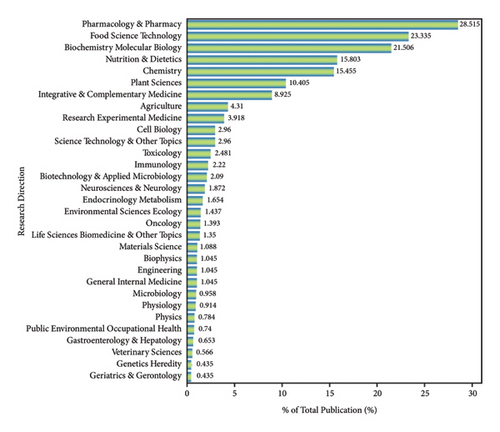
3.5. Key Literature and Cocitation Analysis
Literature analysis plays a fundamental role in helping scholars quickly grasp the foundational achievements in their field. Table 4 presents the top 30 most frequently cited literature in this research area, with the cited number indicating the number of citations in the WoS core database. Notably, four articles have received over 800 citations each. “Vegetables and Fruit in the Prevention of Chronic Diseases,” a critical review published in 2012, has the highest citation frequency, with an impressive 1049 citations. It is worth noting that almost half of the 30 articles mentioned are focused on phenolic compounds. This highlights the significant potential of plant polyphenols in preventing and treating chronic diseases. The top 30 classic literature in this field, selected based on the cocited relationship, is presented in Table 5. “Polyphenols: Food Resources and Bioavailability” is ranked as the first among them. Reviews are the most commonly cited and cocited literature in the field of literature.
| Rank | Cited number | The title of the article | Year | Journal | |||
|---|---|---|---|---|---|---|---|
| Name | Country | Impact factor (2022) | H-index (2022) | ||||
| 1 | 1049 | Critical Review: Vegetables and Fruit in the Prevention of Chronic Diseases | 2012 | European Journal of Nutrition | Germany | 4.865 | 103 |
| 2 | 947 | Oxidative Stress, Prooxidants, and Antioxidants: The Interplay | 2014 | Biomed Research International | USA | 3.246 | 147 |
| 3 | 941 | Nrf2 Signaling Pathway: Pivotal Roles in Inflammation | 2017 | Biochimica et Biophysica Acta-Molecular Basis of Disease | Netherlands | 6.633 | 162 |
| 4 | 806 | Phenol-Explorer: An Online Comprehensive Database on Polyphenol Contents in Foods | 2010 | Database-The Journal of Biological Databases and Curation | United Kingdom | 4.462 | 71 |
| 5 | 651 | Health-Promoting Components of Fruits and Vegetables in the Diet | 2013 | Advances in Nutrition | USA | 11.567 | 103 |
| 6 | 636 | Skin Photoprotection by Natural Polyphenols: Anti-inflammatory, Antioxidant, and DNA Repair Mechanisms | 2010 | Archives of Dermatological Research | Germany | 3.033 | 84 |
| 7 | 612 | Oxidative Stress and Metabolic Disorders: Pathogenesis and Therapeutic Strategies | 2016 | Life Sciences | United Kingdom | 6.780 | 174 |
| 8 | 599 | The Immunomodulatory and Anti-inflammatory Role of Polyphenols | 2018 | Nutrients | Switzerland | 6.706 | 143 |
| 9 | 572 | Antioxidant Phytochemicals for the Prevention and Treatment of Chronic Diseases | 2015 | Molecules | Switzerland | 4.927 | 171 |
| 10 | 521 | Position of the American Dietetic Association: Vegetarian Diets | 2009 | Journal of the American Dietetic Association | USA | — | — |
| 11 | 503 | The Strawberry: Composition, Nutritional Quality, and Impact on Human Health | 2012 | Nutrition | USA | 4.893 | 150 |
| 12 | 489 | Position of the Academy of Nutrition and Dietetics: Vegetarian Diets | 2016 | Journal of the Academy of Nutrition and Dietetics | USA | 5.234 | 181 |
| 13 | 483 | The Flavonoid Quercetin in Disease Prevention and Therapy: Facts and Fancies | 2012 | Biochemical Pharmacology | USA | 6.100 | 206 |
| 14 | 468 | Resources and Biological Activities of Natural Polyphenols | 2014 | Nutrients | Switzerland | 6.706 | 143 |
| 15 | 448 | Phenol-Explorer 3.0: A Major Update of the Phenol-Explorer Database to Incorporate Data on the Effects of Food Processing on Polyphenol Content | 2013 | Database-The Journal of Biological Databases and Curation | United Kingdom | 4.462 | 71 |
| 16 | 441 | The Effects of Polyphenols and Other Bioactive on Human Health | 2019 | Food and Function | United Kingdom | 6.317 | 89 |
| 17 | 413 | An Overview of Plant Phenolic Compounds and their Importance in Human Nutrition and Management of Type 2 Diabetes | 2016 | Molecules | Switzerland | 4.927 | 171 |
| 18 | 396 | Lifestyle, Oxidative Stress, and Antioxidants: Back and Forth in the Pathophysiology of Chronic Diseases | 2020 | Frontiers in Physiology | Switzerland | 4.755 | 122 |
| 19 | 387 | The Therapeutic Potential of Apigenin | 2019 | International Journal of Molecular Sciences | USA | 6.208 | 195 |
| 20 | 379 | Carotenoids, Inflammation, and Oxidative Stress-Implications of Cellular Signaling Pathways and Relation to Chronic Disease Prevention | 2014 | Nutrition Research | USA | 3.876 | 97 |
| 21 | 334 | Biosynthesis of Metallic Nanoparticles using Plant Derivatives and their New Avenues in Pharmacological Applications-An Updated Report | 2016 | Saudi Pharmaceutical Journal | Saudi Arabia | 4.562 | 57 |
| 22 | 324 | Microwave-Assisted Extraction of Flavonoids: A Review | 2012 | Food and Bioprocess Technology | USA | 5.581 | 95 |
| 23 | 320 | Coffee: Biochemistry and Potential Impact on Health | 2014 | Food and Function | United Kingdom | 6.317 | 89 |
| 24 | 315 | Dietary Factors Affecting Polyphenol Bioavailability | 2014 | Nutrition Reviews | USA | 6.846 | 160 |
| 25 | 312 | Renoprotective Effect of the Antioxidant Curcumin: Recent Findings | 2013 | Redox Biology | Netherlands | 10.787 | 105 |
| 26 | 311 | Bioactive Compounds and Bioactivities of Ginger (Zingiber officinale Roscoe) | 2019 | Foods | Switzerland | 5.561 | 53 |
| 27 | 296 | Traditional Medicinal Plant Extracts and Natural Products with Activity Against Oral Bacteria: Potential Application in the Prevention and Treatment of Oral Diseases | 2011 | Evidence-Based Complementary and Alternative Medicine | United Kingdom | 2.650 | 100 |
| 28 | 296 | Health Benefits of Whole Grain Phytochemicals | 2010 | Critical Reviews in Food Science and Nutrition | USA | 11.208 | 173 |
| 29 | 294 | Genistein and Cancer: Current Status, Challenges, and Future Directions | 2015 | Advances in Nutrition | USA | 11.567 | 103 |
| 30 | 288 | Dietary Bioactive Compounds and their Health Implications | 2013 | Journal of Food Science | USA | 3.693 | 160 |
- “—” is a missing item.
| Rank | Cited number | The title of the article | Year | Journal | |||
|---|---|---|---|---|---|---|---|
| Name | Country | Impact factor (2022) | H-index (2022) | ||||
| 1 | 85 | Polyphenols: Food Sources and Bioavailability | 2004 | American Journal Of Clinical Nutrition | USA | 8.472 | 368 |
| 2 | 61 | Potential Synergy of Phytochemicals in Cancer Prevention: Mechanism of Action | 2004 | Journal of Nutrition | USA | 4.687 | 288 |
| 3 | 53 | The Health Benefits of Fruit and Vegetables are from Additive and Synergistic Combinations of Phytochemicals | 2003 | American Journal of Clinical Nutrition | USA | 8.472 | 368 |
| 4 | 53 | Bioavailability and Bioefficacy of Polyphenols in Humans. I. Review of 97 Bioavailability Studies | 2005 | American Journal of Clinical Nutrition | USA | 8.472 | 368 |
| 5 | 51 | Plant Polyphenols as Dietary Antioxidants in Human Health and Disease | 2009 | Oxidative Medicine and Cellular Longevity | USA | 7.310 | 134 |
| 6 | 51 | Antioxidant Activity Applying an Improved ABTS Radical Cation Decolorization Assay | 1999 | Free Radical Biology and Medicine | USA | 8.101 | 289 |
| 7 | 47 | Dietary (Poly)Phenolics in Human Health: Structures, Bioavailability, and Evidence of Protective Effects against Chronic Diseases | 2013 | Antioxidants and Redox Signaling | USA | 7.468 | 217 |
| 8 | 42 | The Ferric Reducing Ability of Plasma (FRAP) as a Measure of “Antioxidant Power”: The FRAP Assay | 1996 | Analytical Biochemistry | USA | 3.191 | 201 |
| 9 | 40 | Therapeutic Potential of Resveratrol: The In Vivo Evidence | 2006 | Nature Reviews Drug Discovery | United Kingdom | 112.288 | 370 |
| 10 | 35 | Rapid Colorimetric Assay for Cellular Growth and Survival: Application to Proliferation and Cytotoxicity Assays | 1983 | Journal Of Immunological Methods | Netherlands | 2.287 | 142 |
| 11 | 35 | Chemistry and Biochemistry of Dietary Polyphenols | 2010 | Nutrients | Switzerland | 6.706 | 178 |
| 12 | 34 | Flavonoids: An Overview | 2016 | Journal of Nutritional Science and Vitaminology | Japan | 2.032 | 65 |
| 13 | 33 | Cancer Chemoprevention with Dietary Phytochemicals | 2003 | Nature Reviews Cancer | United Kingdom | 69.800 | 484 |
| 14 | 32 | Dietary Intake and Bioavailability of Polyphenols | 2000 | Journal of Nutrition | USA | 4.687 | 288 |
| 15 | 29 | Antioxidant Activity of Grains | 2002 | Journal of Agricultural and Food Chemistry | USA | 5.895 | 328 |
| 16 | 29 | Free Radicals and Antioxidants in Normal Physiological Functions and Human Disease | 2007 | International Journal of Biochemistry and Cell Biology | United Kingdom | 5.652 | 200 |
| 17 | 28 | Benefits of Polyphenols on Gut Microbiota and Implications in Human Health | 2013 | Journal of Nutritional Biochemistry | USA | 6.117 | 147 |
| 18 | 28 | Antioxidant and Antiproliferative Activities of Common Fruits | 2002 | Journal of Agricultural and Food Chemistry | USA | 5.895 | 328 |
| 19 | 27 | Anthocyanidins and Anthocyanins: Colored Pigments as Food, Pharmaceutical Ingredients, and the Potential Health Benefits | 2017 | Food and Nutrition Research | Sweden | 3.221 | 52 |
| 20 | 27 | Oxidative Stress, Inflammation, and Cancer: How Are They Linked? | 2010 | Free Radical Biology and Medicine | USA | 8.101 | 289 |
| 21 | 26 | Polyphenols: Chemistry, Dietary Sources, Metabolism, and Nutritional Significance | 1998 | Nutrition Reviews | USA | 6.846 | 167 |
| 22 | 26 | Chemistry and Biological Activities of Flavonoids: An Overview | 2013 | Scientific World Journal | USA | — | 116 |
| 23 | 26 | Structure-Antioxidant Activity Relationships of Flavonoids and Phenolic Acids | 1996 | Free Radical Biology and Medicine | USA | 8.101 | 289 |
| 24 | 25 | Flavonoid Antioxidants: Chemistry, Metabolism, and Structure-Activity Relationships | 2002 | Journal of Nutritional Biochemistry | USA | 6.117 | 147 |
| 25 | 25 | Health-Promoting Components of Fruits and Vegetables in the Diet | 2013 | Advances in Nutrition | USA | 11.567 | 120 |
| 26 | 24 | Resveratrol Improves Health and Survival of Mice on a High-Calorie Diet | 2006 | Nature | United Kingdom | 69.504 | 1331 |
| 27 | 24 | Dietary Phenolics: Chemistry, Bioavailability, and Effects on Health | 2009 | Natural Product Reports | United Kingdom | 15.111 | 200 |
| 28 | 24 | Cancer Chemopreventive Activity of Resveratrol, A Natural Product Derived From Grapes | 1997 | Science | USA | 63.714 | 1283 |
| 29 | 24 | Natural Products as Sources of New Drugs from 1981 to 2014 | 2016 | Journal of Natural Products | USA | 4.803 | 155 |
| 30 | 24 | Health Benefits of Whole Grain Phytochemicals | 2010 | Critical Reviews in Food Science and Nutrition | United Kingdom | 11.208 | 193 |
- “—” is a missing item.
3.6. Visual Analysis of Keyword Hotspots
Paper keywords serve as highly condensed summaries of the central theme and content of full-text research papers. They are essential tools for investigating the focus of scholars in a particular field and can reflect the trends and research hotspots of a theme’s evolution in that field over a certain period. In this study, we analyzed the keywords appearing in the field of phytochemicals in chronic diseases using different software and methods. Although the results obtained varied, the hot keywords were generally similar. Figure 8(a) shows the clustering of keywords into six clusters. The size of each sphere reflects the frequency of the keyword’s occurrence, while the color depth indicates the temporal distance. Figure 8(b) highlights the top five keywords prevalent in this field, namely, “oxidative stress,” “in vitro,” “NF-kappa-B,” “antioxidant activity,” and “phenolic compounds.” These findings suggest that research in this domain predominantly focuses on the mechanisms of action and active substances. Figure 8(c) shows the visual word dynamics of the keywords commonly used by the author according to the keyword dynamic trend map. Research on phytochemicals in the context of chronic diseases has experienced significant growth, particularly after 2017. Moreover, the growth rate concerning “inflammation,” “antioxidation,” “oxidative stress,” and “polyphenols” is notably rapid. This finding further suggests that phytochemicals will continue to be researched for these crucial aspects of chronic disease.
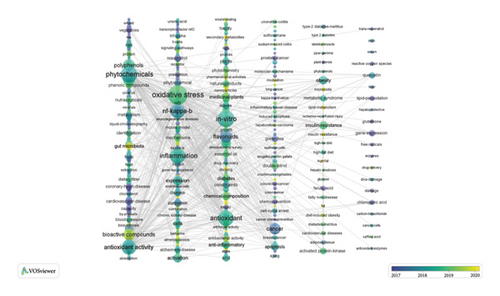
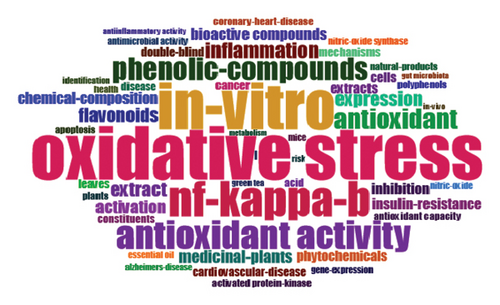

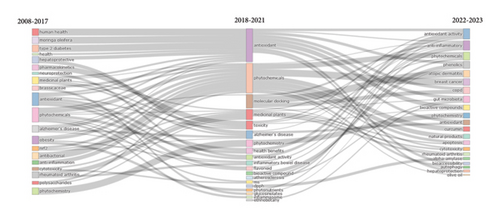

The graph shown in Figure 8(d) presents the topic of evolution analysis. Our data have been divided into three parts with 2017 and 2021 serving as nodes. The nodes in the graph represent the main research topics generated from coword network analysis in each time slice. The size of each node represents the number of keywords contained within each topic. Topics from adjacent time slices are connected by streamlines when they have common keywords. The width of the streamlines is proportional to the number of shared keywords, indicating their relevance. From the graph, we can observe that the pattern of research topics has shifted from dispersion to conformity and then back to dispersion over time. In the early stages (2008–2017), the research topics mainly revolved around human health, type 2 diabetes, and antioxidants. In the second stage (2018–2021), the broad antioxidant effects of phytochemicals were identified. With the emphasis on diet and nutrition, the research on phytochemicals in diseases guided by basic research has increased gradually but not limited to the first stage of type 2 diabetes, obesity, and Alzheimer’s disease. In the third stage (2022-2023), the research field has become more comprehensive, mainly involved the study of mechanisms of action such as antioxidant and anti-inflammatory; research on chronic diseases such as chronic obstructive pulmonary disease (COPD), breast cancer, and rheumatoid arthritis; and a study on the role of phenolic resin, curcumin, and other phytochemicals, as well as edible oil, cruciferous plants, and other foods rich in phytochemicals. Overall, keywords associated with inflammation, oxidative stress, and metabolism persist throughout the evolutionary timeline. Keyword emergence refers to the appearance of frequently used keywords during a specific period, reflecting the research focus and direction to some extent. The diagram in Figure 8(e) illustrates the different types of phytochemicals such as flavonoids, anthocyanins, phenolic acids, and β-carotene, which are associated with chronic diseases including cardiovascular disease, coronary heart disease, and colon cancer. The diagram also highlights the keywords of pathogenesis, mass spectrometry, and toxicity analysis, which are potential research hotspots for phytochemicals in the prevention and treatment of chronic diseases. In recent years, there has been an increased frequency of certain keywords in research, including animal models, leaf extracts, randomized controlled trials, and double-blind studies, suggesting that these areas will likely be the focus of future research.
3.7. Supplementary Analysis of Keyword Measurement
Factor analysis is a comprehensive combination of factors at all levels in the field to analyze the main effects and interaction effects of each factor. To better understand the main topics and themes of a research article, it is helpful to analyze the author’s keywords and group them into clusters on a two-dimensional graph. The points in Figure 9(a) that represent the keywords show how frequently they appear in the article. The closer the points are to each other, the more similar the distribution of the keywords is. In addition, the distance of a keyword from the center of the graph indicates its level of popularity in the research field. Keywords that are closer to the center receive more attention from the research community, while those that are further away are less relevant to the research topic.
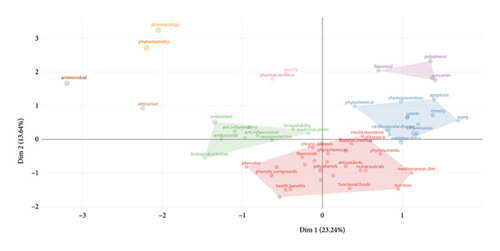

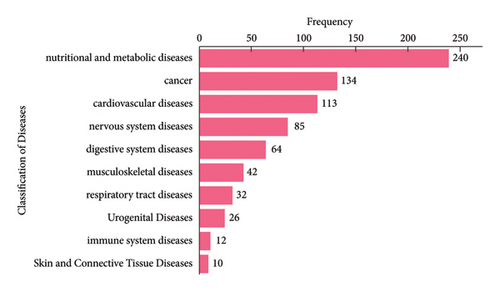
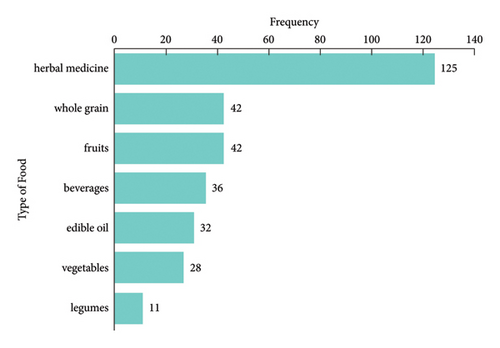
Based on the author’s keywords, the graph can be divided into four main clusters. The red-labeled cluster occupies the largest portion and includes most of the essential concepts in the research field such as chronic diseases, insulin resistance, phenolic compounds, functional foods, and the Mediterranean diet. These are also the most studied directions in this field. The blue-labeled cluster on the right side of the figure is marked by the study of the mechanism of phytochemicals, oxidative stress, and inflammation in diseases such as cancer, obesity, cardiovascular disease, and aging. The green-labeled cluster on the left side of the figure involves the study of the main functions of phytochemicals, including antioxidation, anti-inflammation, and neuroprotection. Its bioavailability has also received extensive attention. The purple-labeled cluster in the upper right corner of the figure is mainly related to the study of flavonoids, polyphenols, and curcumin, which are also the most extensively researched phenolic compounds in phytochemicals. Due to insufficient research, the remaining scattered keywords may not be clustered.
Moreover, conducting a keyword analysis can promptly determine the main theme and focus of this area of study. The research also categorizes the findings manually into three groups based on the frequency of keywords and identifies the fundamental theme of phytochemicals in the context of chronic diseases, which is also the primary direction of research in this field. Furthermore, the topic will be discussed in greater detail during the discussion.
4. Discussion
The research on phytochemicals and their potential benefits for chronic diseases is growing rapidly. In 2022, the number of studies in this field reached 371, which is more than triple the number of studies conducted in 2016. Phytochemicals are present in plant-based foods, and studying their physiological activity and mechanisms in the human body has revealed their potential benefits for chronic diseases. The significant increase in the number of studies confirms the promising outlook of phytochemicals in chronic diseases, and more attention and in-depth research are needed in this field. China leads in the number of publications in this field, which can be attributed to its traditional vegetarian dietary habits and the cultural concept of “food as medicine” in traditional Chinese medicine. The United States and India have also shown significant contributions. Cornell University in the United States has a higher publication volume, likely owing to its robust scientific research foundation. India, with its ancient medical traditions and rich biodiversity, is gradually increasing its research on phytochemicals. An analysis of the top 30 most cited articles in the field revealed that phenolic compounds are a focus. Half of the studies are focused on this topic, indicating their significant role in the field of chronic diseases. The keywords, which also represent the main research areas in this field, have been manually categorized as follows.
4.1. Phytochemicals Are Diverse and Interact with Each Other
Plant chemical compounds come in a wide variety, with phenolic compounds, terpenes, sulfides, alkaloids, plant sterols, plant estrogens, and saponins being the most commonly used in treating chronic diseases. Phenolic compounds are the primary bioactive non-nutrients present in food and are among the most extensively studied [7]. The studied phenolic compounds include resveratrol, curcumin, anthocyanins, catechins, lignans (silymarin), flavonols (quercetin and rutin), isoflavones, proanthocyanidins, and flavonoids (apigenin). Refer to Figure 9(b) for more information.
Phytochemicals, which are naturally occurring compounds found in plants, play a crucial role in these health benefits. Consuming natural and diverse foods can greatly benefit our health, especially when it comes to chronic diseases such as cancer, Alzheimer’s disease, cardiovascular disease, and type 2 diabetes. For example, garlic contains a variety of sulfur-containing compounds such as allicin, anisole, and sulfide, as well as flavonoids such as quercetin. These compounds possess various biological characteristics such as anti-inflammatory, anticancer, antioxidation, antiatherosclerosis, and immune regulation properties, making them highly beneficial for our overall well-being [8]. However, plant development is hindered by two major challenges. First, the synthesis and accumulation of secondary metabolites in plants is a highly intricate process that is influenced by various internal factors such as regulatory genes and enzymes, as well as external factors such as light, temperature, water, salinity, and seasonal changes. In addition, gene expression and protein activity involved in secondary metabolic pathways can vary with growth and environmental conditions [9]. Therefore, evaluating and quantifying the specific components in plants can be a complex task. Nevertheless, it is also necessary to explore the metabolic pathway changes of the main active components of phytochemicals. As can be seen from Figure 8(e), keywords such as molecular mechanism and pathogenesis have also been the focus of research in recent years. The rise of methods such as plant tissue culture will be another platform for researchers and the pharmaceutical industry to improve the production of valuable phytochemicals under pressure from climate change factors [7].
Second, most research studies focus on individual compounds, although phytochemicals in food are typically not found in isolation. Consuming whole fruits or vegetables is often more advantageous than taking individual dietary supplements. This may be due to the interaction among the various phytochemicals coexisting in natural foods [10]. The interaction of phytochemicals can modify their biological properties and bioavailability. Synergistic effects of different phytochemicals can enhance antioxidant, anti-inflammatory, and antiproliferative actions. However, other food components may weaken these effects [11]. Therefore, further exploration is needed to understand how different phytochemicals interact and their bioavailability. This will help in the selection of foods that can provide synergistic effects and avoid antagonistic effects, leading to significant prevention of chronic diseases. In addition, many phytochemicals have not been approved for use in food due to restrictions imposed by regulations on both pharmaceuticals and food.
4.2. Phytochemicals Come from a Wide Range of Sources and are Abundant in Food and Medicinal Plants
Phytochemicals are naturally occurring compounds found in plants. Medicinal herbs are the primary focus of research on chronic diseases, followed by whole grains (such as wheat, rice bran, and seeds), fruits (such as apples, grapes, strawberries, and berries), beverages (such as green tea, red wine, coffee, and propolis), edible oils (such as moringa oil, olive oil, and essential oils), vegetables (including cruciferous vegetables), and legumes (as seen in Figure 9(c)).
Plants that can regulate human functions and treat diseases are commonly referred to as medicinal plants. They are the foundation of ethnomedicine and traditional medicine. For example, white willow produces aspirin, foxglove contains digoxin, ephedra has ephedrine, and sweet wormwood yields quinine and artemisinin, among others, all of which are used in medicines. Botanical sources have been a significant contributor to the development of drugs. Recent research has indicated that medicinal plants can improve cardiovascular disease-related conditions by regulating cellular and molecular metabolism and interfering with risk factors for cardiovascular diseases [12]. They can also affect cellular transcription and the cell cycle in multiple ways, ultimately resulting in increased levels of various proteins and cell cycle inhibitors. This leads to properties that are antitumor and antiapoptotic [13]. Medicinal plant secondary metabolites are the basis of clinical drugs, yet the potential therapeutic value of phytochemicals remains underexplored.
Growing studies [14] have shown that the health benefits of fruits, vegetables, and whole grains are due to a combination of nutrients and phytochemicals present in whole foods. However, low intake of these foods is still the primary dietary risk factor for death and disability around the world [15]. In recent years, research has revealed that consuming whole grains can significantly decrease the risk of developing type 2 diabetes, cardiovascular disease, and cancer. In a study conducted by Yang et al. [16], they analyzed the specific phytochemicals present in whole grains and their food products using a high-throughput multitarget quantitative analysis. They were able to create a whole grain-specific phytochemical fingerprint that can be used as a basis for further research on molecular mechanisms. Fruits and vegetables are known to be highly nutritious crops. However, the peels of many fruits are often discarded as waste in various agricultural and food industries. These peels actually contain a significant amount of antioxidants, such as phenolic compounds, and should be valued for their nutritional benefits. Fruit peels contain a significant amount of nonextractable polyphenols that have the potential to make up to 50% of the total polyphenols present [17, 18]. As a result, nonextractable polyphenols are a valuable resource for further research and extracting them poses a challenging task in this field. In addition, studies have shown that ginger and hibiscus can help regulate blood pressure, while aloe vera, brown seaweed, and spirulina can benefit blood lipids and blood sugar control. These benefits are due to the presence of phytochemicals such as polyphenols and saponins. However, due to high heterogeneity between individuals, the results may not be applicable to everyone [19]. This means that the optimal dosage of phytochemicals for humans has not been reported yet, as it is subject to individual variations, plant species, and interactions between bioactives.
4.3. Phytochemicals have a Variety of Physiological Activities and have Multiple Targets for the Prevention and Treatment of a Variety of Chronic Diseases
Phytochemicals have numerous physiological activities and multitarget effects, which are beneficial in the prevention and treatment of various chronic diseases. According to Figure 9(d), nutritional and metabolic chronic diseases such as type 2 diabetes, obesity, metabolic syndrome, and insulin resistance are the most commonly affected by phytochemicals, followed by cancer (including colorectal, breast, lung, and liver cancer), cardiovascular disease (atherosclerosis, hypertension, and hyperlipidemia), nervous system disease (including neurodegenerative diseases such as Parkinson’s and Alzheimer’s, neuroinflammation, multiple sclerosis, and epilepsy), digestive system disease (inflammatory bowel disease, ulcerative colitis, colitis, liver fibrosis, and nonalcoholic liver disease), musculoskeletal disease (rheumatoid arthritis, osteoarthritis, and osteoporosis), respiratory disease (asthma and COPD), urinary system disease (chronic kidney disease, renal fibrosis, and hyperuricemia), and immune system disease (allergy and allergic dermatitis), among others such as new coronary, psoriasis, endometriosis, periodontitis, and depression. Many types of chronic diseases have been associated with oxidative stress and inflammation, as studies have shown. As evidenced by Figure 8(d), keywords related to inflammation, oxidative stress, and metabolism are present throughout the study, indicating that the mechanism of phytochemicals on various chronic diseases may be related.
Cancer treatment options are constantly expanding, and phytochemicals are one such option. These chemicals are found in plants and are used to create anticancer drugs such as paclitaxel. Cancer prevention has also entered the realm of targeted therapy, and food containing phytochemicals can regulate key cellular signal transduction pathways. This makes them effective in preventing and treating cancer. Various studies indicate that natural products that target the arachidonic acid pathway are effective in treating different types of cancer [20] such as morin. Morin has a molecular chemopreventive action that targets NF-κB, which makes it a potent anti-inflammatory and proapoptotic agent for colon cancer prevention [21]. Resveratrol, which is present in foods such as grapes, berries, soybeans, pomegranates, and peanuts, may be involved in various molecular targets of cellular processes. These processes include cell proliferation, apoptosis, EMT/metastasis, I/II phase detoxification system, epigenetic response, and chemotherapy sensitization. Thus, resveratrol shows potential for preventing and treating breast cancer [22]. In addition, phytochemicals can directly target the insulin-like growth factor 1 receptor (IGF1R) oncoprotein. IGF1R can form heterodimers with insulin receptors and mediate insulin signal transduction. It is involved in different types of cancers such as lung, breast, and prostate [23]. The potential health benefits of phytochemicals in our diet, particularly their antiangiogenic effects, have been extensively studied. Myricetin is a flavonoid that naturally occurs in fruits, vegetables, tea, and wine. In low concentrations, myricetin can protect cells from oxidative stress induced by peroxide molecules by inhibiting reactive oxygen species. Furthermore, myricetin has been shown to prevent breast cancer cell apoptosis and necrosis due to oxidative stress. In addition, myricetin can enhance the activity of antioxidant enzymes to inhibit oxidative stress and reduce inflammation [24]. Brassinolide is a phytochemical found in cruciferous vegetables that has been studied for its antitumor effects. It has been shown to inhibit the growth and migration of endothelial cells, which are important for forming blood vessels that supply tumors with nutrients. By targeting these cells, it can reduce the blood supply to tumors and impair their growth. This potent antiangiogenic activity may be the primary mechanism of its antitumor effects. Therefore, phytochemicals such as brassinolide have great potential in cancer prevention [25]. In conclusion, phytochemicals have the potential to be valuable in the prevention of cancer.
Obesity is linked with the occurrence and development of numerous chronic diseases that are not communicable. However, research has revealed that higher levels of fasting insulin and C-reactive protein can complicate the connection between high BMI (obesity) and an increased risk of death from any cause. Insulin resistance and persistent low-grade inflammation might be the underlying factors behind chronic illnesses [26]. Inflammation is the body’s natural response to infection, injury, or stimulation. The anti-inflammatory effect refers to the regulation of inflammatory cytokines, such as nitric oxide, interleukin, tumor necrosis factor-α, and interferon-γ. Fruits, vegetables, and edible beans contain various phytochemicals that have anti-inflammatory effects and can naturally regulate proinflammatory gene expression [27]. Professor Han Shifan’s team proposed the family nurse diet theory, which suggests that chronic diseases such as cancer and obesity are linked to inflammation, oxidative stress, and metabolic disorders. This theory is based on the immunological and pathological factors that contribute to chronic diseases [28].
Nutrition-related diseases, also known as chronic diseases, are closely associated with diet. Extensive research has been conducted on the link between diet and chronic noncommunicable diseases (NCDs). A 32-year cohort study revealed that those who adhered to a diet pattern of hypoinsulinemia, low inflammation, and reduced diabetes risk had a significantly lower risk of chronic disease [29]. Therefore, healthy dietary patterns can be used to guide future guidelines for chronic diseases. Despite the introduction of guidelines and the adoption of healthy dietary patterns in various countries, what are the underlying mechanisms that are common to them? Professor Han Shifan used ontology thought to summarize that non-nutrients (phytochemicals) have a positive effect on preventing diseases and maintaining health. He put forward the family nurse dietary theory which is a systematic modern diet therapy theory to guide the treatment of chronic diseases. Foods that are rich in non-nutrients can help in treating chronic diseases through three main pathways, namely, antioxidant, anti-inflammatory, and regulating the body’s metabolism. This is similar to the results of our keyword hotspot visualization analysis and may pave the way for future in-depth excavation research. Family nurse dietary theory can serve as a useful guide in clinical practice. It helps to provide personalized and practical diet therapy for patients suffering from chronic diseases. It also assists in explaining factors such as race, cultural preference, life stage, health status, lifestyle, and individual differences in response to dietary intervention, which can improve dietary behavior compliance. The ultimate goal is to prevent and treat chronic diseases effectively [30].
In summary, future research will investigate the molecular mechanism behind the effects of phytochemicals on chronic diseases. This research will also include toxicological studies, in vivo experiments, and clinical trials with humans.
4.4. Future Prospects
In 2017, 11 million deaths worldwide were caused by dietary risk, which accounted for 22% of all adult deaths. Despite efforts to understand what constitutes a healthy diet, the complexity of dietary behavior and the wide-ranging effects of factors such as religious beliefs and geographical habits on diet have made it difficult to achieve an optimal diet. Although healthy foods are consumed worldwide, they still fall short of being optimal [15]. Today, the study of nutrition is not only focused on the ratio of single foods or nutrients and energy supply but also on the selection of a healthy diet structure and food. The best example of this is the “Mediterranean diet.” A prospective study conducted in different countries has verified its beneficial effects on chronic noncommunicable diseases [31]. A study conducted over 32 years found that following a healthy diet can significantly reduce the risk of cardiovascular diseases. Multiple healthy dietary patterns can meet various indicators such as the Healthy Diet Index -2015 (HEI-2015), Alternative Mediterranean Diet Score (AMED), Healthy Plant-Based Diet Index (HPDI), and Alternative Healthy Diet Index (AHEI), which can be tailored to suit different dietary traditions and preferences [32]. However, food choices are influenced by a variety of factors such as individual behavior, race, and socioeconomic background [33]. To provide specific dietary plans that cater to these differences, the family nurse diet therapy theory is highly significant and can help people benefit from long-term healthy diets.
Preventing chronic diseases is crucial, although treating diagnosed chronic illnesses is urgent. The Chinese medical text Huang Di Nei Jing (The Yellow Emperor’s Classic of Internal Medicine) emphasizes the value of prevention in controlling the development of chronic diseases. According to the text, “the upper doctor treats the disease before it occurs, the middle doctor treats the desired disease, and the lower doctor treats the disease that has already occurred.” Thus, national policies should promote healthy diets to limit the burden of chronic diseases and improve environmental sustainability. Nutrition and health policies should encourage the consumption of plant-based foods such as vegetables and fruits, while limiting animal-derived foods. This approach could indirectly reduce the incidence of chronic diseases [3, 34]. On the other hand, it is crucial to strengthen regulations on food safety. The fast-paced economic and social development and the increasing standard of living have led to the frequent occurrence of food production involving chemical additive food, food additives and preservatives exceeding the standard limits, synthetic hormones, and other harmful substances. These factors pose significant threats to human health. Moreover, the consumption of ultraprocessed foods has been linked to various health problems in both adults and children, including cardiometabolic diseases, physical weakness, irritable bowel syndrome, functional dyspepsia, cancer, adolescent metabolic syndrome, and children’s dyslipidemia [35]. In addition, phytochemicals derived from fruits, vegetables, and edible legumes can be incorporated into novel bioactive anti-inflammatory formulations of nutritional health products and drugs [27]. In the United States, drugs such as tamoxifen and finasteride, which target specific molecules, have been approved by the Food and Drug Administration (FDA) for cancer prevention [23]. Prioritizing a plant-based diet is environmentally sustainable and promotes a healthy lifestyle.
The cost of poor dietary habits can result in high healthcare expenses, making prevention crucial. Food as medicine campaigns worldwide, such as in Brazil, Finland, Germany, and Ireland, are often organized by charitable organizations. While in the United States, the campaign is closely linked with the healthcare system. Interventions within the “food as medicine” framework include medically tailored meals, medically tailored food prescriptions (i.e., prescriptions for healthy foods), and prescriptions for agricultural products (such as fruits and vegetables), among others [36]. Incorporating it into healthcare depends on its solid evidence base, which provides clinicians with sufficient support to make informed decisions about diagnosing and treating diseases. On the other hand, national policies must establish long-term coordination between healthcare and the food system to address disease prevention and treatment.
5. Limitation and Advantage
The data used in this study were only obtained from the Web of Science core databases. This is one of the limitations of this article. Although other databases were not included, the study was broad and multidisciplinary. However, the author’s analysis did not distinguish between name abbreviations, which may result in some differences. Moreover, there may be some keyword overlap during manual keyword extraction, but this is inevitable. Nevertheless, the statistical results accurately reflect the problem and are worth considering. In summary, this comprehensive paper presents complete research on phytochemicals in chronic disease, demonstrating their development trends. The obtained results have high credibility, providing a basis for scholarly submissions and a reference for researchers exploring the research frontier.
Due to the increasing number of elderly people, chronic noncommunicable diseases have become a major issue for public health. Cardiovascular disease alone accounts for a third of global deaths [37, 38] and is the leading cause of death among women [39]. The continuous progress of human technology and the improvement of living standards have also led to bad habits such as poor diet, sedentary lifestyle, lack of exercise, long-term use of electronic devices, and staying up late. These habits can cause metabolic disorders and abnormalities in blood lipids, glucose, and pressure [37], which increase the risk of cardiovascular disease. This risk gradually increases as people age [40]. Since the twenty-first century, there has been a growing interest in the potential of phytochemicals to prevent chronic diseases. These substances have been shown to reduce the risk of conditions such as cardiovascular disease, neurodegenerative disease, obesity, diabetes, and cancer by regulating the body’s oxidative stress, inflammation, and metabolic pathways [41]. Today, phytochemicals may be indispensable for preventing chronic diseases. However, the bioavailability of phytochemicals is relatively low. To what extent are phytochemicals absorbed in the human body? What are the phytochemical requirements for different chronic diseases? What are the specific levels of phytochemicals in different foods? Future research should focus on this to better understand the mechanisms by which phytochemicals are metabolized in the human body, which is critical to exploring the potential of phytochemicals in the prevention and treatment of chronic diseases.
6. Conclusions
This study is based on bibliometric analysis and systematically evaluated the association between phytochemicals and chronic diseases through 2,297 publications of Web of Science from 2008 to 2023. According to the analysis of the publications and references, it could be found that the study of shared mechanisms between phytochemicals and metabolic diseases caused by changes in insulin levels or insulin resistance has attracted widespread attention. Both China and the United States have made significant contributions to the number of publications. Research institutions in the United States and India have contributed to the centrality of publications. Combining the burstness analysis of keywords and references, possible directions for future research could be determined. Future research will be conducted on the bioavailability of plant chemicals, optimal human intake, and molecular mechanisms of action against chronic diseases in order to find new directions for the prevention and treatment of chronic diseases. This not only highlights the current research hotspots but also highlights the areas that require further exploration.
Disclosure
Disclaimer/Publisher’s Note: The statements, opinions, and data contained in all publications are solely those of the individual author(s) and contributor(s) and not of MDPI and/or the editor(s). MDPI and/or the editor(s) disclaim responsibility for any injury to people or property resulting from any ideas, methods, instructions, or products referred to in the content.
Conflicts of Interest
The authors declare that they have no conflicts of interest.
Authors’ Contributions
Z.Y.W. conceptualized and visualized the study, developed the methodology, performed the formal analysis, investigated the study, collected the resources, and wrote the manuscript. N.L.B. conceptualised the study, developed the methodology, collected the resources, and reviewed and edited the manuscript. C.Y. wrote, reviewed, and edited the manuscript and conceptualized the study. Z.R.F. collected the resources and visualized the study. H.S.F. collected the resources and reviewed and edited the manuscript. All authors have read and agreed to the published version of the manuscript.
Acknowledgments
The authors extend their recognition and gratitude to the Dietary Therapy Science and Technology Research Center of Shanxi Medical University. This work was supported by the Dietary Therapy Science and Technology Research Center of Shanxi Medical University.



